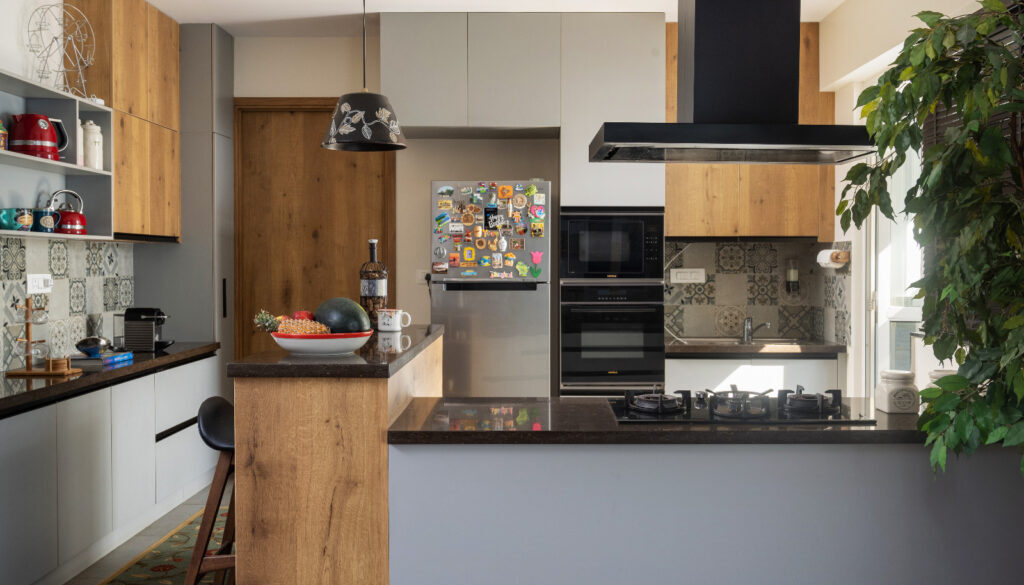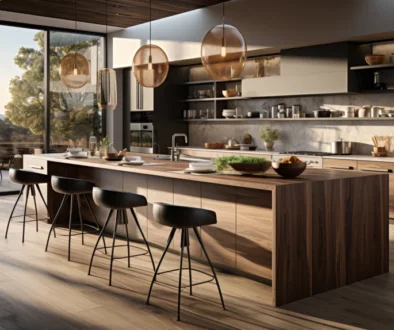10 Common Kitchen Countertops for Your Dream Kitchen
Choosing a kitchen countertop impacts both how your kitchen works and how it looks. At WEA Designs, we help homeowners pick materials that fit their cooking habits, family needs, and personal style. Materials like marble, quartz, and wood each offer distinct benefits, from elegance and durability to a warm, welcoming feel.
These options help create kitchens that match each homeowner’s unique needs and taste. The material you choose for your kitchen countertop shapes both the look and how well your kitchen works. A good choice balances durability, easy care, and style.
This review examines 10 popular countertop materials in Bangalore homes. It describes the main features, care needs, and style options for each one. By combining design trends with proven tips, this guide helps homeowners and pros create kitchens that look great and last.
1. Quartz Countertops
Engineered quartz, created from stone aggregates and polymer resins, makes a durable, non-porous countertop that resists stains and scratches. Unlike marble and granite, quartz comes in more colors and patterns, allowing greater design flexibility and helping achieve a modern look in modular kitchens.
Granite is known for its heat resistance and unique veining, but quartz is popular for its even appearance and low maintenance. Using light-colored quartz with dark cabinets can make kitchens seem larger and support modern urban design.
With its visual appeal, durability, and ease of care, engineered quartz competes with other premium materials and is a top choice for those balancing beauty with function.
2. Granite Countertops
Granite countertops are a popular choice because each piece is unique, adding character to every kitchen. Granite resists heat and scratches, making it great for busy kitchens.
For example, our team used dark granite with wooden cabinets in a Bangalore home, creating a warm and practical space. This shows how the right materials can make kitchens both good-looking and strong.
3. Marble Countertops
Marble countertops look beautiful, with a unique pattern and a smooth surface. However, marble can stain and scratch, especially from acids or heavy use. Sealing it helps, but it needs more care than quartz or granite, which are tougher. Our team suggests using marble on areas like kitchen islands, where looks matter more than heavy use. This way, homeowners get luxury without worrying about damage from daily tasks.
4. Solid-Surface Countertops
Solid-surface countertops, such as those manufactured under the Corian brand, are composed of advanced acrylic or polyester composite materials. These surfaces are distinguished by the seamless integration of joints, which produces a continuous, unbroken aesthetic well-suited to minimalist design schemes.
Such attributes make solid surfaces highly desirable in modern urban apartments, where spatial efficiency and contemporary stylistic coherence are often prioritized.
In recent residential projects, design professionals have selected solid-surface countertops for their ability to deliver both subtle elegance and practical advantages, including nonporosity, ease of cleaning, and stain resistance.
For instance, homeowners in these localities have favored integrated sink and countertop installations made possible by the adaptability of solid-surface materials, thereby achieving a unified, low-maintenance kitchen environment.
5. Wooden Countertops
Wooden countertops possess an inherent aesthetic appeal, often valued for their ability to introduce natural warmth and authenticity into kitchen environments. When properly sealed, hardwood surfaces become moisture- and stain-resistant, making them suitable for sustained daily use.
Solid wood is particularly well-suited for Scandinavian, rustic, or farmhouse kitchen designs, where its organic qualities contribute to both visual and tactile comfort. In professional practice, our Bangalore design teams frequently specify wood island countertops with stone edging, achieving a balanced interplay between inviting warmth and structural durability.
For optimal performance and longevity, it is recommended to regularly reapply food-safe sealants and promptly address spills to prevent water damage and surface degradation.
6. Stainless-Steel Countertops
Stainless steel countertops, common in restaurants, are now used in homes for their modern, practical look. The non-porous surface keeps food prep areas clean.
In a recent project, we used stainless steel in a Bangalore loft to create a kitchen that is both stylish and easy to maintain. Stainless steel fits well in modern spaces that prioritize simple cleaning and a sleek look.
7. Concrete Countertops
Concrete countertops give kitchens a bold, custom look with a variety of finish options. They work well in modern spaces because of their smooth, strong surfaces. Our Bangalore studio polishes or seals concrete to keep it looking good and lasting longer. Because concrete can stain without proper sealing, regular care is important to maintain its strength and appearance.
8. Ceramic Tile Countertops
Ceramic tile countertops come in many colors and patterns, fitting any kitchen style. They cost less, and you can replace one tile without redoing the whole counter. However, you need to clean and seal the grout often, or it can stain.
9. Soapstone Countertops
Soapstone countertops are distinguished by their smooth texture, characteristic grey-green hues, and notable resistance to heat and staining, even without additional surface sealing. Over time, soapstone develops a natural patina that enhances its visual appeal, making it particularly well-suited to transitional kitchen designs that integrate traditional and contemporary elements.
According to our interior design team in Bangalore, the understated elegance of soapstone allows it to harmonize with a variety of materials and stylistic schemes, especially in spaces aiming for a refined, yet approachable ambiance.
In contrast, granite—though highly durable—retains a more static appearance and requires periodic sealing to avoid staining, which may restrict its aesthetic adaptability in hybrid or evolving kitchen environments. This comparison highlights soapstone’s unique ability to bridge divergent design modalities while offering practical performance benefits.
10. Laminate Countertops
Contemporary laminate countertops are engineered to closely replicate the visual characteristics of marble, wood, or stone, while significantly reducing material and installation costs.
Owing to their lightweight composition and low maintenance requirements, laminates are particularly well-suited for compact urban apartments and rental properties where budgetary constraints are paramount.
For example, in several recent Bangalore renovation projects, homeowners have selected premium laminate finishes to achieve the appearance of high-end materials without incurring substantial expenses, thereby illustrating the material’s capacity to deliver both aesthetic versatility and cost efficiency.
How to Choose the Perfect Countertop for Your Kitchen
The right surface should match how you cook, clean, entertain, and live every day. Here’s what our kitchen design experts at WEA Designs recommend considering before you decide:
- Usage: Love to cook often or host dinner nights? Go for quartz or granite, both are durable, heat-resistant, and built for everyday life.
- Budget: Working within a limit? Laminate or ceramic tile gives you style and practicality without stretching your budget.
- Maintenance: Prefer a low-effort surface? Avoid high-maintenance options like marble or wood unless you are ready for periodic care.
- Aesthetics: Your countertop should harmonize with your cabinet finishes, lighting, and overall home palette to create a cohesive visual flow.
At WEA Designs, we emphasize the integration of both aesthetic design and functional utility in every kitchen project. Our approach involves a systematic evaluation of client lifestyle, architectural layout, and lighting conditions to determine the most suitable material selection
The selection and implementation of countertops are guided by a holistic consideration of individual needs and spatial characteristics, ensuring each kitchen meets the highest standards of both form and function.




